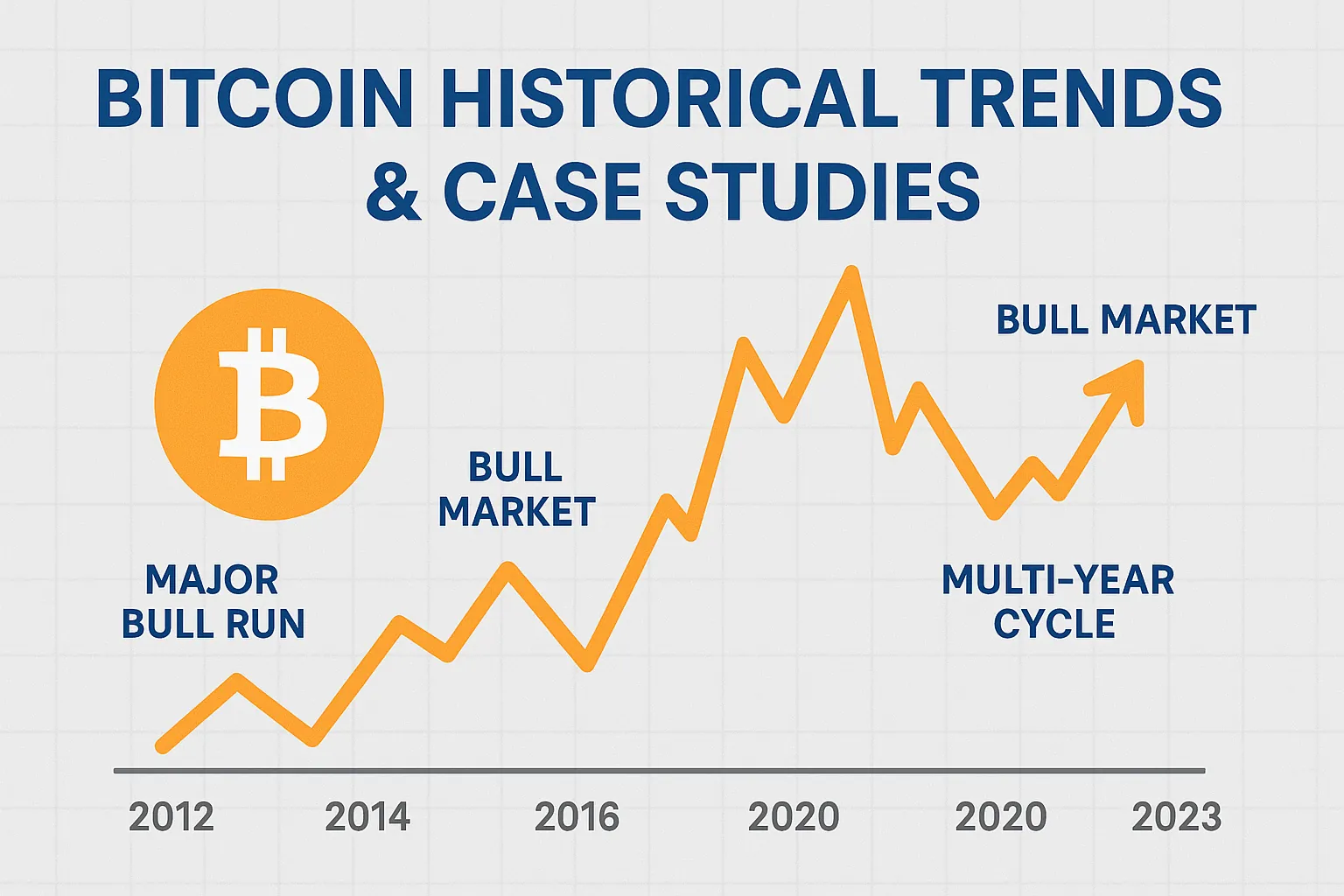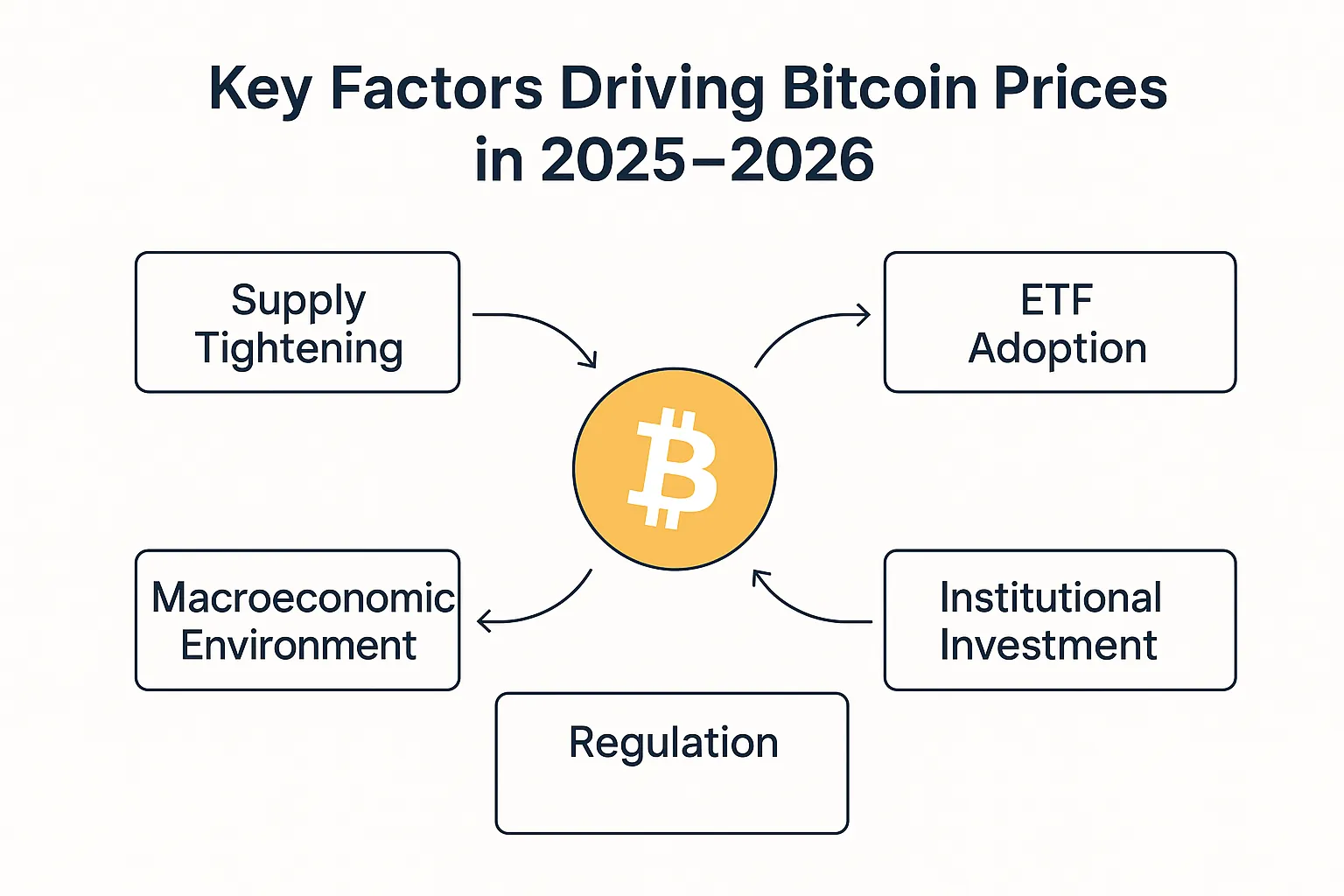
Bitcoin Price Predictions & Forecast for 2025-2026
Quick Summary – Bitcoin Price Predictions & Forecast for 2025 – 2026
Bitcoin is entering a pivotal stage as global regulations tighten, institutional adoption rises, and blockchain innovations unfold. This forecast explores short-term and long-term scenarios, expert opinions, and real-world case studies to help you decide if BTC is worth buying, holding, or selling over the next two years.
Table of Contents
- Introduction: Why Bitcoin’s 2025–2026 Outlook Matters
- Key Factors Driving Bitcoin Prices in 2025–2026
- Expert Predictions & Price Scenarios
- Historical Trends & Case Studies
- Risks, Volatility & Regulatory Impacts
- How to Position Your Portfolio for BTC’s Future
- FAQs – Bitcoin Price Predictions
1. Introduction: Why Bitcoin’s 2025–2026 Outlook Matters
Bitcoin’s journey from an obscure digital currency to a global financial asset has been nothing short of remarkable. As we approach 2025 and 2026, the conversation around BTC’s future has intensified. Analysts, institutional investors, and retail traders are debating whether this will be the decade when Bitcoin becomes a mainstream store of value — or remains a high-volatility speculative play.
Investors are increasingly looking at Bitcoin not just as a speculative trade, but as a way to diversify their portfolio and hedge against inflation. The growing availability of diversified investment strategies:contentReference[oaicite:0]{index=0} and professional trading insights is making it easier for newcomers to understand how BTC can fit into their broader financial plan.
Stay updated with BTC price movements, charts, and breaking news. 📘 Investopedia – Bitcoin Basics
Learn the fundamentals of how Bitcoin works and why it matters.
In addition, niche financial platforms such as Bitcoin FintechZoom analysis:contentReference[oaicite:1]{index=1} provide targeted forecasts and deeper market intelligence. Combining these insights with on-chain analytics and macroeconomic indicators can give traders a competitive edge.
Pros & Cons of Tracking Bitcoin’s Outlook
- ✅ Potential Hedge Against Inflation – BTC’s scarcity may protect value over time.
- ❌ High Volatility Risk – Sharp drawdowns remain a reality for traders.
- Bitcoin’s 2025–2026 forecast hinges on regulation, institutional adoption, and tech upgrades.
- Blend multiple market outlooks to avoid over-reliance on a single prediction.
- Consider BTC as part of a diversified investment portfolio — not your only asset.
2. Key Factors Driving Bitcoin Prices in 2025–2026
To forecast Bitcoin’s price for 2025–2026, it’s essential to understand the major drivers influencing its value. From macroeconomic shifts to blockchain innovation, these factors will shape whether BTC breaks new all-time highs or struggles to maintain momentum.
🔍 Major Price Influencers
- Macroeconomic Environment: Global interest rates, inflation trends, and U.S. dollar strength play a critical role in BTC demand.
- Technological Upgrades: Taproot adoption, Lightning Network scaling, and Layer-2 solutions can improve transaction efficiency.
- Institutional Inflows: Spot Bitcoin ETF approvals could dramatically increase liquidity.
- Regulatory Clarity: Pro-crypto policies can fuel growth, while restrictive measures may slow adoption.
Bitcoin’s correlation to traditional assets is evolving. During certain macroeconomic shocks, BTC has behaved like a risk-on asset, while in other periods it acted as a hedge — a dynamic that Ethereum forecasts:contentReference[oaicite:0]{index=0} also show in cross-asset comparisons.
Institutional perspectives on digital asset growth and risks. 🌐 World Bank – Digital Assets Report
Global insights on blockchain adoption and policy.
📌 Pros & Cons of Key Price Drivers
- ✅ Institutional Adoption Can Stabilize Prices – Large players bring long-term capital.
- ❌ Regulatory Crackdowns Can Trigger Sell-Offs – Negative policy shifts may hurt sentiment.
- Macro trends like interest rate cuts could fuel BTC rallies.
- Technological adoption (Lightning Network) can enhance scalability.
- Regulation remains the most unpredictable factor in BTC’s trajectory.

3. Expert Predictions & Price Scenarios
Bitcoin’s next two years will likely be defined by a battle between bullish institutional optimism and cautious regulatory oversight. Some analysts see $200,000 BTC on the horizon, while others warn of prolonged consolidation.
🔮 Price Outlooks from Leading Voices
- Michael Saylor (MicroStrategy): Predicts Bitcoin could surpass $500,000 within the decade, driven by institutional balance sheet adoption.
- Cathie Wood (ARK Invest): Envisions a $1 million BTC by 2030, with $200K possible by 2026 under favorable macro conditions.
- PlanB (Stock-to-Flow Model): Forecasts a post-halving surge, with Bitcoin trading between $100K–$288K in 2025.
As seen in market forecasting challenges:contentReference[oaicite:0]{index=0}, no single model is perfect. A hybrid approach — blending on-chain analytics, macroeconomic indicators, and sentiment analysis — offers the most balanced perspective.
On-chain metrics and investor behavior analysis. 📰 CryptoSlate – Expert Panel
Diverse market opinions from analysts worldwide.
📌 Pros & Cons of Current BTC Predictions
- ✅ Strong Institutional Confidence – Corporate treasuries and ETFs could drive sustained demand.
- ❌ Potential Over-Optimism – Historical models can break under new market conditions.
- Even bullish experts differ widely in their forecasts.
- Stock-to-Flow remains popular but is not foolproof.
- Adopt a strategy flexible enough to handle market surprises.
4. Historical Trends & Case Studies
Understanding where Bitcoin has been is essential to forecasting where it might go. BTC’s price history is marked by cyclical boom-and-bust patterns tied closely to its halving cycles, macroeconomic events, and shifts in investor sentiment.
📈 Major Historical Milestones
- 2012 Halving: BTC rose from around $12 to over $1,100 within a year.
- 2016 Halving: Price climbed from ~$650 to nearly $20,000 by late 2017 before crashing to ~$3,000 in 2018.
- 2020 Halving: From ~$8,500 in May 2020 to an all-time high of ~$69,000 in November 2021.
Each cycle shows that Bitcoin’s volatility can create both enormous gains and steep losses. These patterns are relevant when examining market crash survival strategies:contentReference[oaicite:0]{index=0}, as investors who remained patient during drawdowns often saw significant long-term gains.
🔍 Case Studies
- 2017–2018 Boom & Bust: Retail-driven surge fueled by ICO mania, followed by a severe correction.
- 2020–2021 Bull Market: Institutional entry (Tesla, MicroStrategy) and pandemic stimulus fueled rapid price acceleration.
Detailed insights into global Bitcoin adoption trends. 📰 BBC – The History of Bitcoin
A mainstream look at Bitcoin’s journey from 2009 to now.
📌 Pros & Cons from Historical Performance
- ✅ Consistent Post-Halving Growth – Past cycles often led to significant price appreciation.
- ❌ Steep Corrections – Gains can evaporate quickly during market reversals.
- Bitcoin’s history shows repeating bullish trends post-halving.
- Long-term holders have historically outperformed short-term traders.
- Past performance is not a guarantee of future results — but it offers clues.

5. Risks, Volatility & Regulatory Impacts
While Bitcoin offers the potential for massive gains, it also comes with significant risks. The period of 2025–2026 will likely be influenced heavily by global regulation, market sentiment, and emerging competition from other digital assets and Central Bank Digital Currencies (CBDCs).
⚠️ Major Risk Factors
- Regulatory Uncertainty: Sudden policy changes in the US, EU, or Asia could trigger price shocks.
- Market Manipulation: Whales and coordinated sell-offs can cause extreme volatility.
- Security Threats: Exchange hacks and wallet breaches remain a threat to investor confidence.
- CBDC Competition: National digital currencies could reduce Bitcoin’s role as a payment system.
Risk evaluation is a critical skill in any speculative asset. Similar caution applies when trading in high-risk sectors such as penny stocks:contentReference[oaicite:0]{index=0}, where volatility mirrors crypto’s rapid price swings.
Insights on global cryptocurrency regulation trends. 📜 FATF – Digital Asset Compliance Report
Guidelines for crypto exchanges and service providers.
📌 Pros & Cons of Bitcoin in a High-Risk Environment
- ✅ Potential for Significant Gains – Volatility creates trading opportunities for skilled investors.
- ❌ High Exposure to Sudden Losses – Prices can drop sharply on bad news.
- Stay informed on regulatory developments in key markets.
- Use secure storage methods to protect your Bitcoin holdings.
- Allocate only a portion of your portfolio to high-volatility assets like BTC.
6. How to Position Your Portfolio for BTC’s Future
Bitcoin can be a powerful component of a well-structured investment portfolio — but only if approached with clear strategy and disciplined risk management. Whether you’re a long-term HODLer or an active trader, the key is to balance BTC with other assets to protect your wealth in both bull and bear markets.
📊 Strategic Approaches
- Dollar-Cost Averaging (DCA): Invest a fixed amount at regular intervals to reduce timing risk.
- Diversification: Pair BTC with stocks, bonds, and commodities to create a more stable portfolio.
- Risk Management: Use stop-loss orders and position sizing to protect against sharp downturns.
Investors who want to compare Bitcoin against traditional investments can explore our stocks vs. real estate analysis:contentReference[oaicite:0]{index=0} to see how BTC fits into a broader allocation plan.
Best practices for integrating Bitcoin into your investment strategy. 💡 NerdWallet – Bitcoin Investment Guide
Beginner-friendly advice on when and how to buy BTC.
📌 Pros & Cons of Including BTC in Your Portfolio
- ✅ Potential for High Returns – BTC’s volatility can work in your favor during bull runs.
- ❌ High Risk Profile – Exposure to sudden crashes means position sizing is critical.
- Use BTC as a growth asset, not as the core of your portfolio.
- Rebalance periodically to lock in profits and reduce risk.
- Consider blending BTC with dividend-paying stocks for stability.

7. FAQs – Bitcoin Price Predictions
Below are the most common questions investors ask about Bitcoin’s 2025–2026 outlook. This section is optimized for quick reading and SEO-rich answers to help it rank for long-tail search queries.
❓ Can Bitcoin hit $200K by 2026?
It’s possible if macroeconomic tailwinds, ETF approvals, and institutional adoption continue accelerating. Bullish analysts like Cathie Wood believe $200K is achievable, while conservative models suggest BTC will consolidate between $65K–$80K.
❓ Will regulation kill Bitcoin?
While regulation could slow adoption, it is unlikely to end Bitcoin’s relevance. Nations with pro-crypto frameworks may drive price growth, whereas strict jurisdictions could see reduced participation.
❓ Is now a good time to buy Bitcoin?
That depends on your risk appetite. Long-term investors often prefer dollar-cost averaging to avoid the pitfalls of market timing. This strategy smooths out volatility over months or years.
For more analysis, see our full Bitcoin Price Predictions & Forecast archive:contentReference[oaicite:0]{index=0} for updated market insights.
- BTC could reach $200K in a bullish scenario, but conservative estimates are lower.
- Regulation can shape adoption speed but not eliminate Bitcoin’s core value proposition.
- Use disciplined buying strategies like DCA to manage volatility.
Real-time Bitcoin market news, trends, and expert interviews. 📊 CoinTelegraph – BTC Price Index
Live Bitcoin prices, charts, and in-depth analysis. 📰 Forbes – Crypto & Blockchain
Insights from global finance leaders on Bitcoin’s role in the economy.
📚 Related Reading
- Ethereum Price Prediction: 2025 Outlook:contentReference[oaicite:0]{index=0}
- Bitcoin Market Insights – FintechZoom Analysis:contentReference[oaicite:1]{index=1}
- Why Market Predictions Are Hard:contentReference[oaicite:2]{index=2}
❓ How often should I rebalance my Bitcoin holdings?
Many long-term investors rebalance quarterly or annually, depending on their risk tolerance and portfolio mix.
❓ Is Bitcoin better than Ethereum for 2025?
It depends on your strategy. Bitcoin is often seen as a store of value, while Ethereum offers more utility via smart contracts.
❓ Can I lose all my money in Bitcoin?
While unlikely if stored securely, Bitcoin is a high-risk investment and can experience severe price declines. Invest only what you can afford to lose.
🚀 Ready to Stay Ahead in Crypto?
Get daily market insights, trade alerts, and Bitcoin analysis directly to your inbox. Join TradeStockAlerts.com and make smarter investment moves.
📩 Subscribe Now